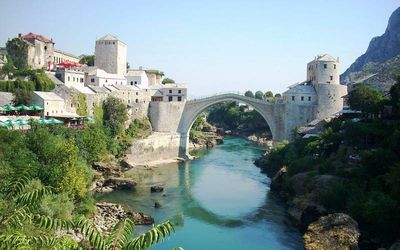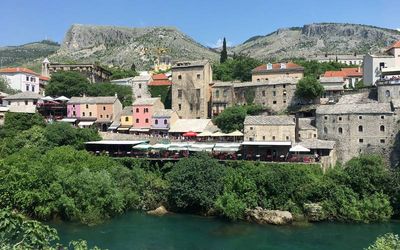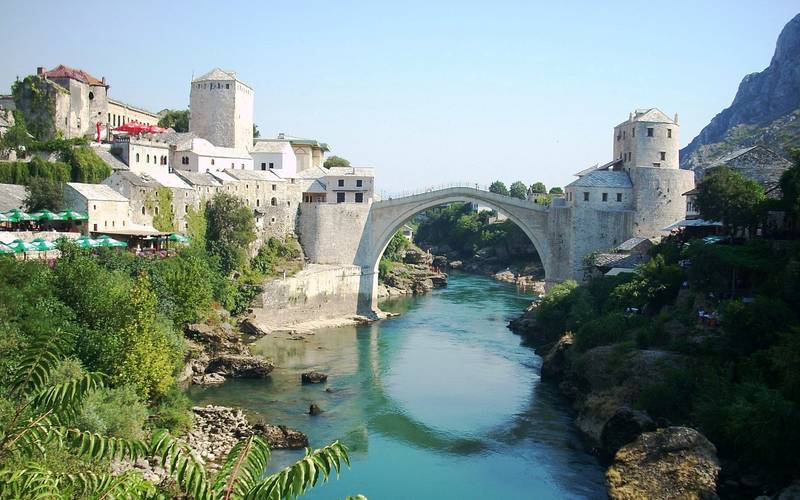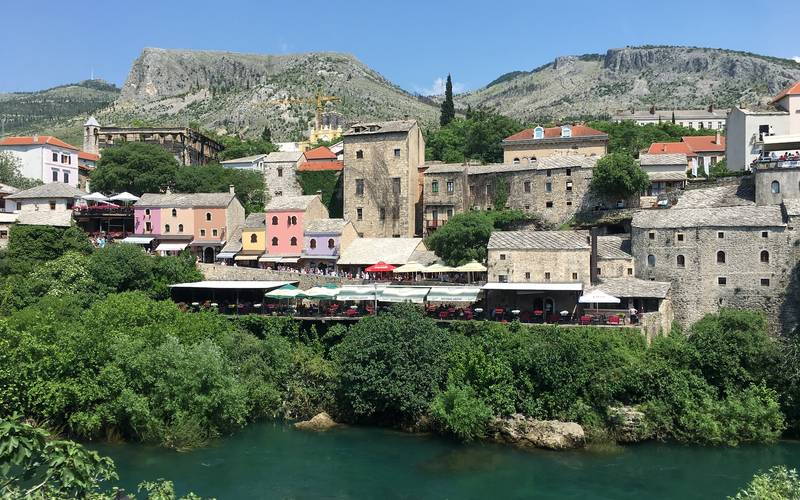What is called "Mostar Bridge" is actually a defensive complex of the sixteenth and seventeenth century. It consists of a bridge over the local river Neretva, and of two military structures that controlled the access.

Stari Most
Magnificent work of art alas destroyed during the war of 1993, the bridge was rebuilt identically by the international community between 2001 and 2004. Nowadays, it has recovered all its luster of antant and serves spearhead in local tourism. It must be said that the city of Mostar, the second largest city in the country by its number of inhabitants and located in the east of Bosnia, is not particularly famous for its tourist activities. The Mostar Bridge, locally known as " Stari Most", is above all a symbol of the bringing together of different living communities on the spot, a perfect emblem of the cultural and religious situation of the Balkans.
Denomination
The old bridge of Mostar is inseparable from the city, it is the symbol and even beyond the city, it is the symbol of Bosnia and Herzegovina. Moreover the connection between this bridge and the city is even more important than one might think at first sight since the word "bridge", in the local language, Serbo-Croat, is said " mostar ". The city is therefore identified locally as "the city of the bridge". In the local language, this bridge is called " Stari Most".
An architectural curiosity
It is a unique arch bridge, which ensures its solidity, 29m long and 4 wide. It is in local stones, stones of the type " tenélija " and " bretcha " extracted from the careers of the city.
Built in 1566 by Mimar Hajrudin , a young architect of the Ottoman Empire then master of the region, this bridge allowed the cultural, religious and economic development of the city at all times. It went through the years without being damaged by time or human activities until 9 November 1993. That day, while the Balkans had been at war since 1992, the bridge was bombarded by Serbian artillery with the aim of cut off communications between Bosnian communities. Only four months after its destruction a call was made for its reconstruction. In December 1995, the Dayton Accords ended the war in the Balkans, with each camp returning to its frontiers. UNESCO then raises funds and organizes the reconstruction project, with the support of local authorities and a scientific and technical committee. The identical reconstruction lasted from 2002 to 2004. The new bridge was inaugurated on July 23, 2004, in a city where the different communities are still not brotherhood.
In the seventeenth century it was added two towers at its entrances, one in the East and the other in the West. It was all the interest of building a bridge to control those who used it. The presence of these strongholds is not surprising. On the left bank, stands the " Tava Tower ", on the right, the " Halebija Tower ".
To go further in its description...
A symbol that made it famous
The bridge is now the symbol of the city of Mostar and even of all Bosnia and Herzegovina. Thanks to him the old city has become world famous and has triggered an ever-increasing influx of tourists. But why is it so important, when it does not seem especially original? Yes, it's beautiful, but it's not the only bridge of its kind, so why is this specific more important than the others?
In fact, it is simply due to the cultural situation of Mostar before the war in the Balkans. It was a cosmopolitan, open-minded city, with a strong mix, although its neighborhoods are strongly borrowed from communitarianism. And it was this specificity that did not please the nationalists who wanted the independence of their countries, once the Soviet bloc fell and by the side effect that Yugoslavia ceased to exist as such. Left to their own devices, the ethnic groups created their own country, but since borders did not go without saying, they fought each other. And a mixed city like Mostar suffered, of course.
If this bridge is so well known, then it is by the fact that it represents a link between the peoples living in the Balkans. But it also has other symbolic meanings.
Learn more about its symbolic
His history
We cannot say that the history of the Mostar Bridge is especially interesting until the war in 1991 ... Built in the 16th century under the Ottoman Empire, we know that it resisted everything, natural disasters, attempts destruction, wars and conflicts of all kinds, but history has not left us anecdotes about its past.
So it takes on importance during its destruction, on November 9, 1993, under the shells of the Croatian artillery. The reasons were both military and cultural, but still he was well shot, effectively separating Bosnian neighborhoods from Croats and Serbs. When it was rebuilt identically, between 2001 and 2004, the international community participated strongly. The engineer was French, the funds came from different European organizations but the hand of work was local, and was chosen among the different communities of the city, to try to make reconciliation around this highly symbolic project.
Nowadays this bridge has an obvious tourist vocation.
Learn more about its history, how to visit it.
Mostar

View of Mostar
Mostar is the second largest city in Bosnia and Herzegovina after the capital Sarajevo. It is the most important city of Herzegovina. It is 150Kms north-west of Dubrovnik, the most famous city of tourists coming to the country. It had 65,286 inhabitants in 2013 including its peri-urban area. If the city is fairly classic, its historic center is a UNESCO World Heritage Site, with the bridge, its fortified ensembles East and West and the streets of the center.
The city has an eccentric historical center to the east, close to the mountains on which s' support the most eastern neighborhoods. At the foot of these mountains runs the Neretva, a stream about ten meters wide, it is above this river that passes the bridge. It is east of Mostar, in the city center. It is not the only bridge in the city of course, there are several, almost an entire 200m, but the others are modern.
Learn more about the location of the Mostar Bridge.
Visit Mostar
We cannot really say that the old bridge of Mostar is visited, it is a simple bridge and as such, apart from admiring the banks of the Neretva and crossing it, there is not much to do. Fortunately one of the two towers of the seventeenth century tower Tara, contains an interesting museum on the bridge, its history, and more particularly on its destruction and reconstruction.
Learn more about tourism in Mostar






















